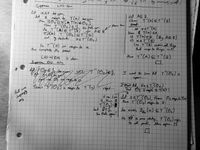Continuous map
- Note: there are a few different conditions for continuity, there's also continuity at a point. This diagram is supposed to show how they relate to each other.
|
[math]\begin{xy}\xymatrix{ \text{Continuous} \ar@2{<->}[d]_-{\text{claim }1} \ar@2{<.>}[drr] & & \\ {\begin{array}{lr}\text{Continuous at }x_0\\ \text{(neighbourhood)}\end{array} } \ar@2{<->}[rr]_{\text{claim }2} & & {\begin{array}{lr}\text{Continuous at }x_0\\ \text{(sequential)}\end{array} } }\end{xy}[/math] |
Note that:
|
| Overview | Key |
|---|
Contents
/Refactoring tasks
Add the following:
- A map is continuous if and only if the pre-image of every closed set is closed
- A map is continuous if and only if each point in the domain has an open neighbourhood for which the restriction of the map is continuous on
Definition
Given two topological spaces [ilmath](X,\mathcal{J})[/ilmath] and [ilmath](Y,\mathcal{K})[/ilmath] we say that a map, [ilmath]f:X\rightarrow Y[/ilmath] is continuous if[1]:
- [ilmath]\forall\mathcal{O}\in\mathcal{K}[f^{-1}(\mathcal{O})\in\mathcal{J}][/ilmath]
That is to say:
- The pre-image of every set open in [ilmath]Y[/ilmath] under [ilmath]f[/ilmath] is open in [ilmath]X[/ilmath]
Continuous at a point
Again, given two topological spaces [ilmath](X,\mathcal{J})[/ilmath] and [ilmath](Y,\mathcal{K})[/ilmath], and a point [ilmath]x_0\in X[/ilmath], we say the map [ilmath]f:X\rightarrow Y[/ilmath] is continuous at [ilmath]x_0[/ilmath] if[1]:
- [ilmath]\forall N\subseteq Y[/ilmath][ilmath]\text{ neighbourhood to } [/ilmath][ilmath]f(x_0)[f^{-1}(N)\text{ is a neighbourhood of }x_0][/ilmath]
Claim 1
Claim: The mapping [ilmath]f[/ilmath] is continuous [ilmath]\iff[/ilmath] it is continuous at every point
- A quick proof I did on some scrap - click for full version
This requires one or more proofs to be written up neatly and is on a to-do list for having them written up. This does not mean the results cannot be trusted, it means the proof has been completed, just not written up here yet. It may be in a notebook, some notes about reproducing it may be left in its place, perhaps a picture of it, so forth. The message provided is:
See image
Sequentially continuous at a point
Given two topological spaces [ilmath](X,\mathcal{J})[/ilmath] and [ilmath](Y,\mathcal{K})[/ilmath], and a point [ilmath]x_0\in X[/ilmath], a function [ilmath]f:X\rightarrow Y[/ilmath] is said to be continuous at [ilmath]x_0[/ilmath] if[1]:
- [math]\forall (x_n)_{n=1}^\infty\left[\lim_{n\rightarrow\infty}(x_n)=x\implies\lim_{n\rightarrow\infty}(f(x_n))=f(x)\right][/math] (Recall that [ilmath](x_n)_{n=1}^\infty[/ilmath] denotes a sequence, see Limit (sequence) for information on limits)
Claim 2
Claim: [ilmath]f[/ilmath] is continuous at [ilmath]x_0[/ilmath] using the neighbourhood definition [ilmath]\iff[/ilmath] it is continuous at [ilmath]x_0[/ilmath] using the sequential definition
Proof: neighbourhood [ilmath]\implies[/ilmath] sequential:
- Let [ilmath](x_n)_{n=1}^\infty[/ilmath] be given, and that [ilmath](x_n)\rightarrow x[/ilmath] - we wish to show that [ilmath]\lim_{n\rightarrow\infty}(f(x_n))=f(x)[/ilmath]
- Let [ilmath]\epsilon > 0[/ilmath] be given.
- By hypothesis, as [ilmath]B_\epsilon(f(x))[/ilmath] is a neighbourhood of [ilmath]f(x)[/ilmath] then [ilmath]f^{-1}(B_\epsilon(f(x)))[/ilmath] is a neighbourhood to [ilmath]x[/ilmath]
- So [ilmath]\exists\delta>0[B_\delta(x)\subseteq f^{-1}(B_\epsilon(f(x)))[/ilmath]
- By the implies-subset relation if [ilmath]B_\delta(x)\subseteq f^{-1}(B_\epsilon(f(x)))[/ilmath] then [ilmath]a\in B_\delta(x)\implies a\in f^{-1}(B_\epsilon(f(x)))[/ilmath]
- So [ilmath]\exists\delta>0[B_\delta(x)\subseteq f^{-1}(B_\epsilon(f(x)))[/ilmath]
- Choose [ilmath]N\in\mathbb{N} [/ilmath] such that [ilmath]n>N\implies d_1(x_n,x)<\delta[/ilmath] (which we can do because [ilmath](x_n)\rightarrow x[/ilmath])
- Note that [ilmath]d_1(x_n,x)<\delta\implies x_n\in B_\delta(x)[/ilmath]
- So [ilmath]x_n\in B_\delta(x)\implies x_n\in f^{-1}(B_\epsilon(f(x)))[/ilmath]
- But if [ilmath]a\in f^{-1}(B)[/ilmath] then [ilmath]f(a)\in B[/ilmath] as [ilmath]f^{-1}(B)[/ilmath] contains exactly the things which map to an element of [ilmath]B[/ilmath] under [ilmath]f[/ilmath]
- So [ilmath]f(x_n)\in B_\epsilon(f(x))[/ilmath]
- By hypothesis, as [ilmath]B_\epsilon(f(x))[/ilmath] is a neighbourhood of [ilmath]f(x)[/ilmath] then [ilmath]f^{-1}(B_\epsilon(f(x)))[/ilmath] is a neighbourhood to [ilmath]x[/ilmath]
- But [ilmath]f(x_n)\in B_\epsilon(f(x))\iff d_2(f(x_n),f(x))<\epsilon[/ilmath]
- Let [ilmath]\epsilon > 0[/ilmath] be given.
- This completes the proof
- we have shown that given an [ilmath]\epsilon > 0[/ilmath] that there exists an [ilmath]N[/ilmath] such that for [ilmath]n>N[/ilmath] we have [ilmath]d_2(f(x_n),f(x))<\epsilon[/ilmath] which is exactly the definition of [ilmath](f(x_n))\rightarrow f(x)[/ilmath]
Proof: sequential [ilmath]\implies[/ilmath] neighbourhood:
TODO: This - See Analysis I - Maurin page 44 if stuck
References
Old page
First form
The first form:
[math]f:A\rightarrow B[/math] is continuous at [math]a[/math] if:
[math]\forall\epsilon>0\exists\delta>0:|x-a|<\delta\implies|f(x)-f(a)|<\epsilon[/math] (note the implicit [math]\forall x\in A[/math])
Second form
Armed with the knowledge of what a metric space is (the notion of distance), you can extend this to the more general:
[math]f:(A,d)\rightarrow(B,d')[/math] is continuous at [math]a[/math] if:
[math]\forall\epsilon>0\exists\delta>0:d(x,a)<\delta\implies d'(f(x),f(a))<\epsilon[/math]
[math]\forall\epsilon>0\exists\delta>0:x\in B_\delta(a)\implies f(x)\in B_\epsilon(f(a))[/math]
In both cases the implicit [math]\forall x[/math] is present. Basic type inference (the [math]B_\epsilon(f(a))[/math] is a ball about [math]f(a)\in B[/math] thus it is a ball in [math]B[/math] using the metric [math]d'[/math])
Third form
The most general form, continuity between topologies
[math]f:(A,\mathcal{J})\rightarrow(B,\mathcal{K})[/math] is continuous if
[math]\forall U\in\mathcal{K}\ f^{-1}(U)\in\mathcal{J}[/math] - that is the pre-image of all open sets in [math](A,\mathcal{J})[/math] is open.
